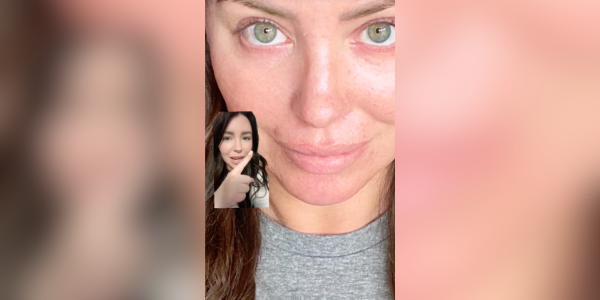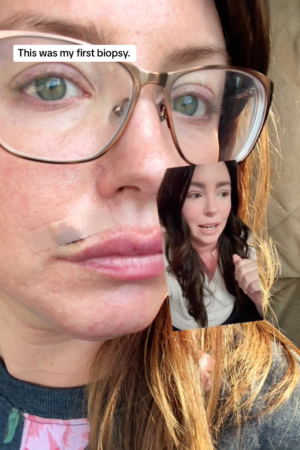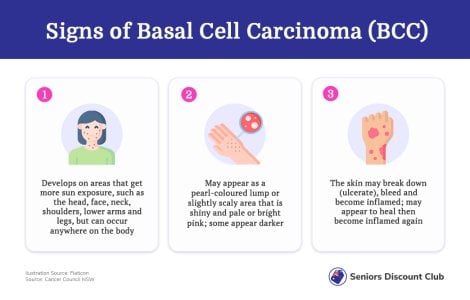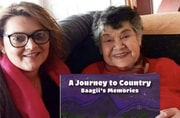This woman discovered 9 'harmless' blemishes that turned out to be cancer
By
VanessaC
- Replies 9
Disclaimer: This article cannot be considered medical advice. Remember to consult with your doctor for any diagnosis.
Australians reportedly have one of the highest skin cancer rates in the world—with two out of three Aussies prone to being diagnosed with some form of skin cancer before the age of 70.
Yet many still assume that any spots and bumps they come across on their bodies are just harmless blemishes.
This might be a huge mistake: Sometimes, if these warning signs remain ignored, one might be putting themself in major danger.
One woman named Molly (40) recently experienced this and has had nine different skin cancers removed in the past five years, and every single time, she assumed each one was nothing more than a minor blemish.
The blemishes included acne spots, bug bites, and even ingrown hairs which turned out to be basal cell carcinoma (BCC) after further inspection from her doctor.
Molly's issues began when she was thirty-five when she went to her dermatologist to ask about an itchy spot on her leg. The doctor dismissed it as nothing more than a common skin issue, but asked Molly about any other issues she was having.
In response, Molly then asked for some pimple cream to treat a spot on her top lip she'd been trying to get rid of. But the doctor's expression changed as soon as she shared this information.
'I have this little, tiny pimple on my lip that is just slow to go away,' Molly said.
'It kind of had the tiniest little whitehead, so I picked the whitehead off, and it bled a little, and I put some pimple cream on it, and then it got a little bit better, but then it came back, and it just won’t go away.'
'(The dermatologist) gave me the look. If you know, you know.'
'He [leaned] in, and then he’s like, “That’s probably skin cancer, I mean, we’ll biopsy it, but from me to you, that’s skin cancer.”'
'It was scary, and kind of like mentally traumatising.' Molly recalled.
Molly was then recommended chemotherapy cream which made her feel unwell '24/7', and subsequently had to have six-hour Mohs surgery—a micrographic technique used to treat and remove skin cancer.
Unfortunately, shortly after, the BCC returned to the same spot and needed an even more invasive procedure to remove it.
'I went in for a spot on my leg and got like 75 stitches in my face instead. I just wanted a pimple cream.'
Sadly in the next five years, she had discovered eight more BCCs. Furthermore, Molly had to take anti-anxiety medication for the procedures as she would suffer from panic attacks during treatment.
'It just feels like I’m going to have to always be doing this,' Molly said.
'Physically, it’s really hard on me to hear the pulling of your skin, and you can hear the cutting.'
'I just keep thinking how many more times am I going to have these?'
She also shared that skin cancer may look different for others, but hers always looked like harmless blemishes.
'My skin cancer looks like little red pimples or bug bites that won’t go away, sometimes, not always, it itches, and sometimes, not always, it flakes, and it will have the slightest like opal sheen to it,' she explained.
'Each time it has been like, is it a pimple, is it a bug bite, is it an ingrown hair, is it something else?'
'They all came back as skin cancer.
'I even had one that looked like a scar, like a scratch that had kind of healed into a tiny scar, like if you banged your shin on a table.'
According to the Kelowna Skin Cancer Clinic, BCC is known to be the most common yet least deadly form of skin cancer with its 0.05 per cent mortality rate. However, one could repeatedly develop more BCCs and even develop either squamous cell carcinoma, or the most dangerous form of skin cancer, which is melanoma.
'(BCC patients’) risk of developing melanoma is more than three times higher than the general population,' the clinic explained.
Molly had reportedly spent $4,000 USD ($6,230 AUD) on skin treatments such as scar reduction. She said: 'Non-deadly skin cancer can still be painful, disfiguring, and really expensive.'
Another social media user shared her mum’s experience with BCC, noting that her BCC is in the advanced stage and had 'metastasised and gone through her skull, and now is attaching to her brain'.
Molly then urged anyone who is doubting their bumps to schedule an appointment with their dermatologist. She also advised women to visit their OBGYN to check their labia and ask their hairdressers to let them know if they spot any bumps on their heads.
'That’s actually how my mum found out she had skin cancer,' she said.
Below are some known signs of basal cell carcinoma:
You can watch Molly’s full video below:
Source: TikTok/@hr_molly.

Members, have you spotted the same bumps in your body? Have you had them checked by your dermatologist? Let us know in the comments below.
Australians reportedly have one of the highest skin cancer rates in the world—with two out of three Aussies prone to being diagnosed with some form of skin cancer before the age of 70.
Yet many still assume that any spots and bumps they come across on their bodies are just harmless blemishes.
This might be a huge mistake: Sometimes, if these warning signs remain ignored, one might be putting themself in major danger.
One woman named Molly (40) recently experienced this and has had nine different skin cancers removed in the past five years, and every single time, she assumed each one was nothing more than a minor blemish.
The blemishes included acne spots, bug bites, and even ingrown hairs which turned out to be basal cell carcinoma (BCC) after further inspection from her doctor.
Molly's issues began when she was thirty-five when she went to her dermatologist to ask about an itchy spot on her leg. The doctor dismissed it as nothing more than a common skin issue, but asked Molly about any other issues she was having.
In response, Molly then asked for some pimple cream to treat a spot on her top lip she'd been trying to get rid of. But the doctor's expression changed as soon as she shared this information.
'I have this little, tiny pimple on my lip that is just slow to go away,' Molly said.
'It kind of had the tiniest little whitehead, so I picked the whitehead off, and it bled a little, and I put some pimple cream on it, and then it got a little bit better, but then it came back, and it just won’t go away.'
'(The dermatologist) gave me the look. If you know, you know.'
'He [leaned] in, and then he’s like, “That’s probably skin cancer, I mean, we’ll biopsy it, but from me to you, that’s skin cancer.”'
'It was scary, and kind of like mentally traumatising.' Molly recalled.
Molly was then recommended chemotherapy cream which made her feel unwell '24/7', and subsequently had to have six-hour Mohs surgery—a micrographic technique used to treat and remove skin cancer.
Unfortunately, shortly after, the BCC returned to the same spot and needed an even more invasive procedure to remove it.
'I went in for a spot on my leg and got like 75 stitches in my face instead. I just wanted a pimple cream.'
Sadly in the next five years, she had discovered eight more BCCs. Furthermore, Molly had to take anti-anxiety medication for the procedures as she would suffer from panic attacks during treatment.
'It just feels like I’m going to have to always be doing this,' Molly said.
'Physically, it’s really hard on me to hear the pulling of your skin, and you can hear the cutting.'
'I just keep thinking how many more times am I going to have these?'
She also shared that skin cancer may look different for others, but hers always looked like harmless blemishes.
'My skin cancer looks like little red pimples or bug bites that won’t go away, sometimes, not always, it itches, and sometimes, not always, it flakes, and it will have the slightest like opal sheen to it,' she explained.
'Each time it has been like, is it a pimple, is it a bug bite, is it an ingrown hair, is it something else?'
'They all came back as skin cancer.
'I even had one that looked like a scar, like a scratch that had kind of healed into a tiny scar, like if you banged your shin on a table.'
According to the Kelowna Skin Cancer Clinic, BCC is known to be the most common yet least deadly form of skin cancer with its 0.05 per cent mortality rate. However, one could repeatedly develop more BCCs and even develop either squamous cell carcinoma, or the most dangerous form of skin cancer, which is melanoma.
'(BCC patients’) risk of developing melanoma is more than three times higher than the general population,' the clinic explained.
Molly had reportedly spent $4,000 USD ($6,230 AUD) on skin treatments such as scar reduction. She said: 'Non-deadly skin cancer can still be painful, disfiguring, and really expensive.'
Another social media user shared her mum’s experience with BCC, noting that her BCC is in the advanced stage and had 'metastasised and gone through her skull, and now is attaching to her brain'.
Molly then urged anyone who is doubting their bumps to schedule an appointment with their dermatologist. She also advised women to visit their OBGYN to check their labia and ask their hairdressers to let them know if they spot any bumps on their heads.
'That’s actually how my mum found out she had skin cancer,' she said.
Below are some known signs of basal cell carcinoma:
You can watch Molly’s full video below:
Source: TikTok/@hr_molly.
Key Takeaways
- A 40-year-old woman, Molly, who has had nine basal cell carcinomas removed, has warned others that each of the cancers she had, initially appeared as harmless blemishes, such as pimples, bug bites and ingrown hairs.
- Molly first became aware of her skin cancer when she was 35 and had gone to a dermatologist for what she believed to be persistent acne.
- After multiple surgeries over five years, often resulting in physical and emotional trauma, Molly has urged those unsure about any skin spots or bumps to immediately see a dermatologist.
- Molly reminds people to be vigilant, advising that non-deadly skin cancer can still be painful, disfiguring and costly, and if unchecked, can metastasise into more severe conditions.










